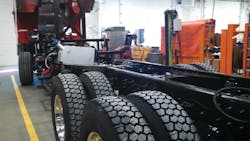So, your fire department is buying a new piece of apparatus. You will probably want to form a committee because that is usually the first step. Committees seem to be the way humans make big decisions that concern a lot of people, but they are not always the most efficient.
Motorized fire apparatus have been around more than 100 years and it is likely a committee was involved in the purchase process from day one. It’s also likely they had lots of people with lots of opinions, even back then, like how much gold leaf should be used, the shade of red to be applied, warning lights and so on. They had way fewer options back then, so the decisions were probably limited.
Consider all options
Fast forward to 2014. Just think of the options available on today’s apparatus – cab configurations, engine size, body material, suspension decisions, pump sizes, tank sizes, scene lighting, hosebed configurations, tool mounting and the list goes on and on.
An apparatus committee’s job is to evaluate the department’s needs, sift through the options and come up with what’s best for the community. In short, the committee is about getting the right piece of apparatus for the right job at the right price. That’s a tall order for anyone, or any group of people, especially firefighters, who are often confident people with opinions on just about everything.
While there are some firefighters who wouldn’t give two nickels to be part of an apparatus committee, there are many more who will want to offer their sage advice and opinions about the apparatus. They have read magazine articles, done lots of Internet searching and may have even gone to a few shows, so they are ready. They all want to be part of the committee, make their marks on the apparatus and have some sort of legacy for the next 20 years, or at least the life of the apparatus.
There’s an old saying that goes something like; “There’s nothing more effective than a committee of one.” That may be a truism, and was perhaps the way business was conducted years ago with the chief or a purchasing agent making apparatus decisions solo, but it is probably not the best way to make apparatus purchasing decisions today.
An apparatus committee should be of reasonable size, probably no larger than 10 people. Resist the temptation to include everyone with an interest on the committee. They may have good ideas, and thoughts, but including everyone in the department on the committee would be cumbersome at best and a waste of time at the worst. That’s not undervaluing their ideas, but those who are truly interested can get their thoughts to the committee through a representative. They will be using the apparatus too and their lives will be just as influenced as well, so they should have a say, just not at the decision-making table.
Those with the biggest stakes in the decision should be part of the committee as should representatives of groups within the department. For instance a career department may want to have members from all shifts represented as well as a union representative. A line officer or two, captain or lieutenant, would be a good idea too. A representative from command or commanding officer, like a battalion chief, or maybe even the chief, could prove helpful. You will need someone with the authority to get the apparatus through the political process, and a commanding officer may help with that navigation. Having the authority to approve the expenditure is a powerful negotiating tool.
Include City Hall
Many departments also have to use purchasing office and financial people at City Hall. They may not know about fire tactics or your operations, but they do know the business side of your department and they will have the ability to review the “fine print” of any bid that may be received and keep the department out of trouble with contract issues. They will also be helpful in performance bonding and penalty clauses for non-compliance.
The committee profile for volunteer departments is not much different. It is likely the chief will want a spot on the committee and a line officer or two should have a seat as well. A rank-and-file member or two will bring a user perspective to the committee as well.
While a community with a volunteer department may not have a municipal manager or a finance officer, there is certainly someone who has final say. In most cases, that will be the voters of the community, so, if they have the final say, why not include an ordinary taxpayer on the committee? That member of the community, especially if well known and respected, may just be the answer to get the apparatus approved. If the taxpayers believe you have justified every component on the apparatus, and you are not buying a new toy, it may prove smooth sailing toward approval.
There is also some value to including the newest recruit on the committee, either for career or volunteer fire departments. That new recruit will be eager to be included and will likely ask questions and force seasoned veterans to justify the specifications through explanations. And, saying something is being done because “that’s the way we’ve always done it” won’t fly.
Fresh ideas and fresh ears and eyes often pay huge benefits. Remember the mission – getting the right apparatus to do the right job at the right price. That does not mean tradition and paradigms will rule the day. And speaking of experience and traditions, try to avoid a committee comprised of a bunch of “old timers” who epitomize the adage of “200 years of tradition unencumbered by tradition.” Someone may have a lot of fire service experience, but there is a lot of new technology and new ideas for fire apparatus on the market today. Remember, the apparatus being specified today will be around for at least 20 years, longer in many cases. There’s no reason to put an apparatus in service with technology that’s been around since 1934 and expect it to be efficient and relevant in 2034.
While buying apparatus can be the most important and arguably among the biggest events firefighters can have in their careers, it should be an exciting and, yes, fun adventure. Pick the people you trust and have good relationships and work together well to serve on the committee. Work to maintain those relationships through the apparatus acquisition process by listening to and respecting each other’s opinions and suggestions.
Remember, you’re all working toward the same goal – getting the right truck for the right job at the right price. Keep that front and center and you will get an apparatus you will be proud to have your fire department’s name on.
8 criteria for success
To make it easier to decide who should be on the committee, here’s a list of do’s and don’ts:
1. Give everyone with a stake in the decision representation at the committee table. Those who have valid interest in the performance and cost of the apparatus need to have decision-influencing authority in the purchase.
2. Firefighters from all shifts who will be using the apparatus for decades need to have a say. They will be counting on the apparatus to perform when lives are at stake. They need to feel that they have been given the best equipment possible and letting them help make the decision will boost their confidence.
3. Include chief officers. Chief officers who are accountable to mayors, city managers, finance officers and ultimately taxpayers and voters also need to have a say – their very jobs could be on the line if a bad choice is made.
4. The people who are paying for the apparatus – the taxpayers – need to have a way to have a say. It can be through a budget committee process, or a selectman or councilor representative on the truck committee. Letting the public see the process and being thoroughly transparent can only yield benefits when a vote is taken. Citizens will know due diligence has been paid and they will be getting the most protection for the money they are spending.
5. Include people with mechanical aptitude, perhaps the shop mechanic or maintenance department representative. Volunteer departments are typically comprised of people with a wide variety of talents. Perhaps there is a contractor with heavy equipment experience, or a farmer who knows about mechanical things, or a truck driver who may understand horsepower and torque and the difference. Or maybe there is a banker who knows all about bonding and finances. Firefighting for them is an avocation and experience from their daily vocational jobs can be invaluable.
6. Consider including an apparatus consultant on your committee, or at least as an advisor. The typical fee is 1% to 2% of the total purchase and consultants can often save way more than that by ensuring money is well spent.
7. Don’t include people on the committee who have axes to grind or personal advantages to gain. They will come in with the sole mission of defeating the purchase or steering the purchase to a particular brand or type of apparatus he or she prefers. That destructive force will surely have a souring effect on the purchasing experience and could lead to broken relationships and apparatus that people will resent it for years to come.
8. Resist the temptation to include apparatus salespeople on your committee. While it might be true the firefighter who sells apparatus brand XYZ has a lot of experience with apparatus specifications, the committee will be better served to truly look at needs, options and specifications offered by a wide variety of manufacturers. If the mission truly is to get the right truck for the right job at the right price, keeping an open mind to all vendors is important. Because of the personal relationship the committee may have with the sales representative, there will likely be a natural and understandable bias toward the product he or she is offering. It’s best to keep things as generic and open as possible.
About the Author

Ed Ballam
Ed Ballam served as associate editor for Firehouse. He is the assistant chief of the Haverhill Corner, N.H. Fire Department, and a National Registered EMT. He is also a Deputy Forest Fire Warden for the New Hampshire Division of Forests and Lands. Professionally, he's been a journalist for over 35 years working for a variety of publications, including employment as managing editor of a national fire service trade journal for more than a decade.
